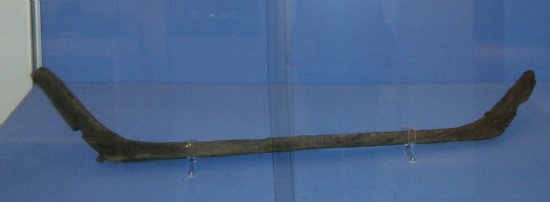Rubh' an Dunain Boat Timber
01 December 2019
- News Type:
- Find of the Month

© Museum of the Isles, Armadale Castle
Loch na–Airde and its surrounding structures have long been a site of archaeological interest, recognised as a potential focus for maritime activity. An underwater survey of the loch in 1995 by the Scottish Trust for Underwater Archaeology recorded the presence of waterlogged wooden objects in its silty shallow bed. In 2000, the levels of the loch were exceptionally low, and a boat timber of oak was discovered and recovered from its reeded northern margins. This timber was subsequently lodged with Inverness Museum and underwent assessment by the SUERC who radiocarbon dated the timber to the Medieval period.
The timber has been recognised as part of a clinker built vessel. It has upturned ends and spans 1.19m. One end (the left hand end as pictured), is complete, but the top part of other end is missing. It has been identified as a bite, a light cross beam with rising arms that connected the top planks of a hull above the frames in the northern European clinker tradition. At the centre of its lower face is a hole, 20mm in diameter, which would have received a strut secured into the floorboard beneath. The angle of the arms, and the presence of two treenails surviving on one side, suggest that there were two upper strakes (planks) which would have been 15mm thick.
The vessel that this component was a part of was likely to be similar to the small faering (a four oared, two man rowing boat) found with the AD 950 Viking ship burial at Gokstad, Norway, or the later faering found at Sogndal, Norway. The former example was 6.1m long, with only three strakes on each side, the uppermost supported by the bite, while the second example was 5.6m long with four strakes either side, the upper two supported by the bites. A reconstruction drawing of the Rubh’ an Dùnain bite shows a four strake faering, estimated to be 5.86m long and 1.32m wide.
The radiocarbon dates obtained for the timber (1165-1260 cal AD at 1 sigma, 1060-1280 cal AD at 2 sigma) place it firmly within the late Norse/Medieval period. Norse vessel of this size range seem to have been quite common in Western Scotland, and the clinker tradition was very long lived here. It is possible that this bite fragment was washed into the loch by storms, but in 2006, a second oak boat timber was recovered from the margin of the loch as well. This was identified as the lower frame of a clinker-built vessel considerably larger than the faering component. Given this second component, and the presence of other reported boat timbers in the loch bed, it seems likely that both are the remains of boats associated directly with maritime function of the loch at its associated features. Given the Norse/Medieval date of the bite, some of the complex must have thus been in operation in these periods.
This bite is a very important find, as diagnostic medieval boat fragments and components are exceptionally rare in Scotland. The only other surviving examples are two end posts for boats of clinker tradition from Eigg, which were radiocarbon dated to the early Norse period. Eigg is only 27km by sea from Rubh’ an Dùnain, and the site which they are from, which has traditional Norse associations, may be another very similar site to the maritime complex at Rubh’ an Dùnain. Other evidence takes the form of iron rivets, impressions of vessels, or very fragmentary remains from boat burials. Examples of these come from Smoo Caves (Sutherland), Scar and Westness (Orkney), and Swordle Bay (Ardnamurchan).
The site which the boat fragment is from is a regionally and nationally important site (see Site of the Month, December 2019). Part of this is owed to the medieval boat timber itself, due to the extreme paucity of this material from Scottish contexts. Since there may be further boat fragments in the loch, and the site very strongly merits further investigation. A possible assemblage of boat fragments, from which a series of vessels could be reconstructed, would be a remarkable and invaluable resource for understanding Scotland’s maritime past.
The boat timber is on loan from HES to the Museum of the Small Isles where it is on display.
Further Information
Martin, C. 2009. Rubh' an Dùnain, Bracadale, Skye: Data Structure Report. Morvern Maritime Centre. (Available through HER record)
Martin, C. & Martin, P. 2018. Rubh' an Dùnain: a multi-period maritime landscape on the Isle of Skye, Inner Hebrides, Scotland. The International Journal of Nautical Archaeology. Vol. 47, Issue 1: 140-158 (Available with subscription)
Links
https://her.highland.gov.uk/Monument/MHG4895
https://canmore.org.uk/site/11028
Report contributed by Grace Woolmer
Find of the Month Archive
- 25/07/2022 Steatite Vessels
- 10/04/2021 Cruisie lamp in Dunrobin Castle Museum
- 02/03/2021 Medieval Sword Pommel from Sleat, Skye
- 01/02/2021 Hilton of Cadboll Pictish Cross Slab
- 04/01/2021 Gunflint from Stoneyfield, Inverness
- 02/12/2020 Bobbin from Contin Bobbin Mill
- 02/11/2020 Russian Lead Cloth Seal from Cromarty
- 01/10/2020 The Poolewe Hoard
- 04/09/2020 Storr Rock Viking Silver Hoard
- 07/08/2020 Mesolithic bloodstone artefacts from Camas Daraich, Skye
